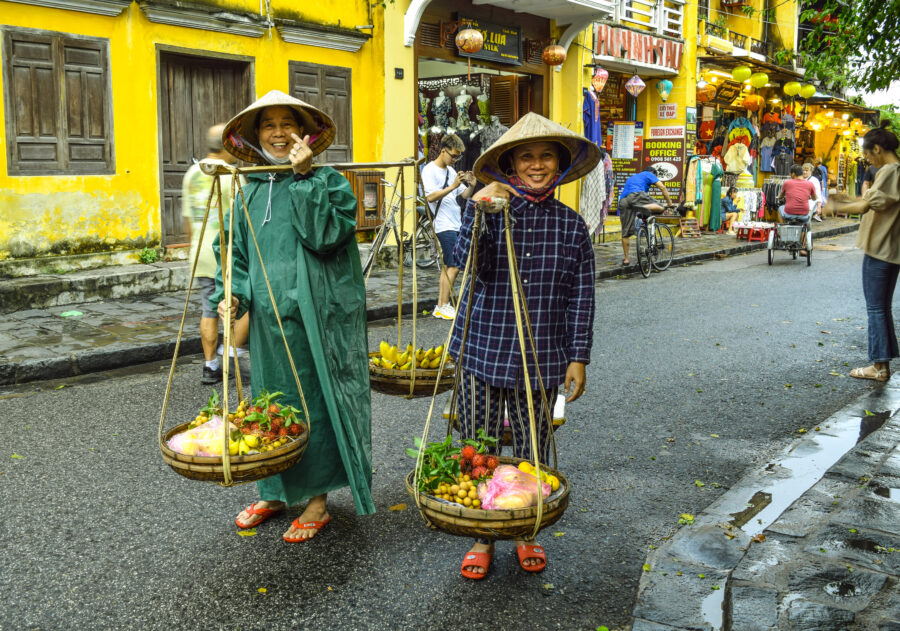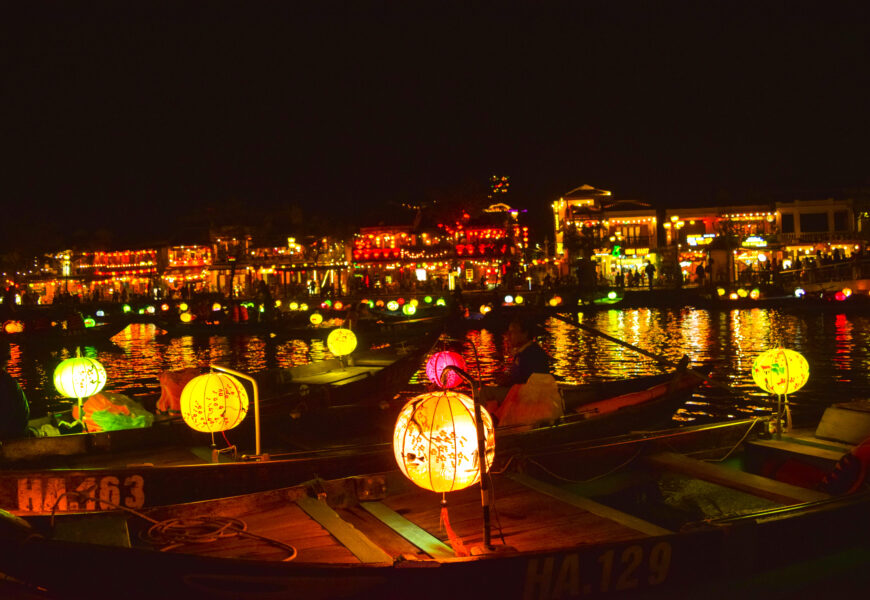
At first look, Hoi An came across as stubbornly traditional and jam-packed with sights, exuding a laid-back but almost dreamy atmosphere. Hoi An is intriguing with its narrow street comprising wooden-fronted shops, its legacy of tottering Japanese houses, Chinese merchant buildings, temples, and warehouses, and an incredible charm that hangs in every lane. The ancient town brushed in mustard yellow and festooned with colorful silk lanterns, offers a finer and deeper insight into the amalgam of styles from China, Europe, and Japan. The Unesco World Heritage tag in 1999 boosted the revival of Hoi An, and with that tourism grew, and a multitude of tour buses and resorts lined up in the town. And Hoi An has been able to maintain its old-world charm, albeit with concerted efforts like placing restrictions on motorbikes, or issuing a mandate on local businesses, by law, to dangle lanterns from their facades.

My first stop in the town was the famed two-story restaurant called Banh Mi Phuong. The Banh Mi is a sandwich that is made with a French baguette, pate, meats, and fresh herbs and is a perfect blend of French tradition and modern Vietnamese culture. The place came into prominence when Anthony Bourdain declared the baguette a triumph. And Hoi An is as much for gastronomic delights as it is for its sights. But let’s cover the gastronomic side of this town in a separate blog.
Step back in time
The narrow lanes of the old town are steeped in history and culture. And though most of the shophouses have been repurposed with restaurants, cafes and a glut of tailor and leather shops, the ones open for tourists provide a panoramic view of how life had been in bygone eras. I started my old town tour with the two-century-old Tan Ky house. The entry is through the old town tour ticket of $5 which provides entry into five of the old buildings. The house with its intricately carved columns and beams, and an open roof courtyard, offers a glimpse of the old life – of the days when Hoi An was an important trading port, and Thu Bon River was a jostling crowd of merchant vessels representing the world’s great trading nations.

Cultures melted and merged into each other in Hoi An, a timeless air, that this amicable town still emanates. But no fusion has been greater than the Chinese culture in Hoi An. The most noteworthy monuments in the town come from the resident Chinese population. One of the mention-worthy halts is the Phuc Kien, one of five assembly halls built by Chinese merchants to plot trade deals and honor ancestors. The building has a sea goddess temple that holds an unforgettable statue of an aquamarine-skinned goddess.
Another Chinese temple that is regarded as a must-visit in Hoi An is the Quan Cong Temple. The temple was built in the early 17th century to honor the Chin Dynasty, but nowadays it serves as one of Hoi An’s most spectacular architectural accomplishments.
And then towards the end of the lane is the Japanese bridge with an arched pagoda. The Japanese bridge is possibly the most famous landmark of the town.


Pencil in some time to take a truncated tour of Vietnam’s ethnic communities at the Precious Heritage Museum, opened in 2017 by the French photographer Réhahn. Rehahn has spent eight years exploring ethnic communities of Vietnam, photographing villagers and different shades of their lives. The museum is a gallery of his works, including the famed ‘hidden smile’ which was presented to the French President. The shot is a close-up of a puckish woman in a conical hat covering her forehead and mouth with her hands, taken at the banks of a river in Hoi An.
On a silk row
One of the things that many travelers fancy in Hoi An are getting themselves a silk dress in one of the 600 tailor shops in the town. The turnaround time is less than 24 hours. Just bring your favorite design to the shop, and get a silk dress in an enviable time.
The magical stroll in the old town
Hoi An is all about a slow, luxurious stroll along its narrow streets, breathing in every shade of the town: the amalgam of cultures, the fusion delights, the photogenic heritage, and the doyenne of dishes on the street. And while you walk, keep an eye on Hoi An’s architectural emblems: the “eyes” watching over the entrance to a house or religious building. These eyes are driven as protection against the evil forces, a practice that is picked from the pagodas of Northern Vietnam. In some assembly halls, you will also find the Yin and Yang symbols, which became more common around the nineteenth century.

Take a walk around the river in the evening to catch the moments in the river as the boatsmen ready their boats for the evening rides. Every boat has lanterns festooned on them just like the shops have been mandated. And as it gets darker, the boats with the lanterns on the river look akin to the fireflies in the jungle.
These streets host some of the famed eateries of Hoi An, apt places to try local dishes. Most emblematic of its multicultural past is the Cao Lau – which has flavors of Japan in the thick rice noodles, China in savory soy porn, and French in rice flour croutons. Try it at the Hoi An market – a favorite place to try some local dishes.

At night step into the side street and Hoi An’s main night market. Pencil your way through the bicycle-topped pancake carts to the shops alight with silk lanterns. Walk a little more on either side, and you’ll find Hoi An’s favorite eat-out places to enjoy a good drink with live music. If not that, walk to the riverside, and for 120,000 dongs (close to five dollars) for 15 minutes, you can step into a little wooden boat, and join the flotilla.
From the boat with a profusion of lanterns and their reflection on the dark river water, Hoi An appears as an artist’s creation crafted with some extraordinary finesse from the wooden boat.


Sun and surf
The mesmerizing sea and sand with moderate surf, and a view of the Cham islands on the horizon, make Hoi An even more ravishing. Spend your morning breathing in the calmness of Tan Thanh Beach. The sea gives a different shade to this ancient town steeped in its cultural past.
The adrenaline-infused coracle ride
I had to miss this one, but I’ll recommend you pencil in some time in the morning, and take a half-hour drive to the ancient town, to ride a basket boat through river channels thick with water coconut trees. I am pretty certain the coracle ride appears on the top things to do in Hoi An in any random google search and tops every social media content based on Hoi An.
Best time to visit Hoi An
Unline Northern Vietnam which sees four seasons, central Vietnam has just two seasons dry (Feb-Aug) and wet (Sept-Jan). Weather-wise, the best time to visit Hoi An is from February to April. In the dry season, it may get quite hot with temperatures reaching 35 degrees Celcius, during the months of June to August. The wet season is unpredictable, and heavy showers are frequent which may come with typhoons and flooding, especially in October and November. Another factor that you may consider is the Tet Holiday, or the Vietnamese New Year, in late January to early February. Many restaurants and shops will be closed during this time and hotel rates will be at their highest.



